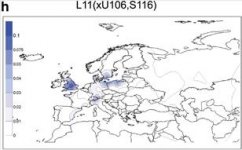Goga
Banned
- Messages
- 2,651
- Reaction score
- 152
- Points
- 0
- Y-DNA haplogroup
- R1a*
- mtDNA haplogroup
- HV1b2
Yeah, all these mutations are very young and they all occurred in Europe. But R1b lineage in general is at least 18,000 years old! So R1b in every European male is at least 18,000 years old.if you take a look at the various R1b markers relevant for Western Europe, they are consistently younger:
L23 - 5000 BC
L11 - 4,000 BC
P312 - 3,300 BC
U106 - 1,500 BC
U152 - 1,500 BC
L21 - 2,000 BC
Z196 - 1,800 BC
It's even possible that your most recent mutation of R1b was 50 years ago. But this doesn't mean tha your R1b is 50 years old. It's still at least 18,000 years old!




